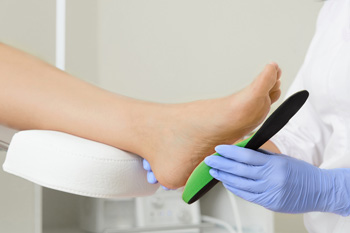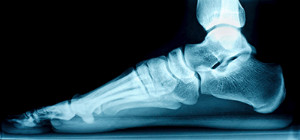Blog - Foot Doctor, Chambersburg and McConnellsburg, PA
Reasons for Reconstructive Foot Surgery
 Foot reconstruction is a type of surgery that is performed to correct the anatomy of the foot and restore proper function. Someone might need reconstructive foot surgery following a major injury to the foot that affects the foot’s soft tissue or bones. Vascular diseases, which can interfere with circulation in the lower limbs, may require surgical intervention. Other issues which can cause deformities include metabolic diseases, such as diabetes and gout, that alter the blood and nerve supply of the foot, and tumors. Finally, birth defects such as clubfoot would also need to be corrected via reconstructive surgery. For more information on reconstructive foot surgery, please consult with a podiatrist.
Foot reconstruction is a type of surgery that is performed to correct the anatomy of the foot and restore proper function. Someone might need reconstructive foot surgery following a major injury to the foot that affects the foot’s soft tissue or bones. Vascular diseases, which can interfere with circulation in the lower limbs, may require surgical intervention. Other issues which can cause deformities include metabolic diseases, such as diabetes and gout, that alter the blood and nerve supply of the foot, and tumors. Finally, birth defects such as clubfoot would also need to be corrected via reconstructive surgery. For more information on reconstructive foot surgery, please consult with a podiatrist.
Foot surgery is sometimes necessary to treat a foot ailment. To learn more, contact Dr. Steven Schwartz of Pennsylvania. Our doctor will assist you with all of your foot and ankle needs.
When Is Surgery Necessary?
Foot and ankle surgery is generally reserved for cases in which less invasive, conservative procedures have failed to alleviate the problem. Some of the cases in which surgery may be necessary include:
- Removing foot deformities like bunions and bone spurs
- Severe arthritis that has caused bone issues
- Cosmetic reconstruction
What Types of Surgery Are There?
The type of surgery you receive will depend on the nature of the problem you have. Some of the possible surgeries include:
- Bunionectomy for painful bunions
- Surgical fusion for realignment of bones
- Neuropathy decompression surgery to treat nerve damage
Benefits of Surgery
Although surgery is usually a last resort, it can provide more complete pain relief compared to non-surgical methods and may allow you to finally resume full activity.
Surgical techniques have also become increasingly sophisticated. Techniques like endoscopic surgery allow for smaller incisions and faster recovery times.
If you have any questions please feel free to contact our offices located in Chambersburg, and Mcconnellsburg, PA . We offer the newest diagnostic and treatment technologies for all your foot and ankle needs.
Should I Use Custom Orthotics?
 Orthotics are devices used to help correct, support, and align different ailments, injuries, or deformities the body may be experiencing. Orthotics are often a common method of treatment in the world of podiatry, acting as a supportive and corrective device for a number of different conditions. Most orthotics come prefabricated, but a podiatrist can take the time to have a fitting with their patients, making sure it’s custom molded for their needs. It’s essential to get a proper fitting orthotic device, that way you can prevent any additional issues from developing. Some common foot conditions orthotics have been known to help are bunions, plantar fasciitis, heel spurs, and neuromas. If you have a foot condition you believe could benefit from the aid of an orthotic device, please consult with a podiatrist for their professional advice and a proper fitting consultation.
Orthotics are devices used to help correct, support, and align different ailments, injuries, or deformities the body may be experiencing. Orthotics are often a common method of treatment in the world of podiatry, acting as a supportive and corrective device for a number of different conditions. Most orthotics come prefabricated, but a podiatrist can take the time to have a fitting with their patients, making sure it’s custom molded for their needs. It’s essential to get a proper fitting orthotic device, that way you can prevent any additional issues from developing. Some common foot conditions orthotics have been known to help are bunions, plantar fasciitis, heel spurs, and neuromas. If you have a foot condition you believe could benefit from the aid of an orthotic device, please consult with a podiatrist for their professional advice and a proper fitting consultation.
If you are having discomfort in your feet and would like to try orthotics, contact Dr. Steven Schwartz from Pennsylvania. Our doctor can provide the care you need to keep you pain-free and on your feet.
What Are Orthotics?
Orthotics are inserts you can place into your shoes to help with a variety of foot problems such as flat feet or foot pain. Orthotics provide relief and comfort for minor foot and heel pain but can’t correct serious biomechanical problems in your feet.
Over-the-Counter Inserts
Orthotics come in a wide variety of over-the-counter inserts that are used to treat foot pain, heel pain, and minor problems. For example, arch supports can be inserted into your shoes to help correct overarched or flat feet, while gel insoles are often used because they provide comfort and relief from foot and heel pain by alleviating pressure.
Prescription Orthotics
If over-the-counter inserts don’t work for you or if you have a more severe foot concern, it is possible to have your podiatrist prescribe custom orthotics. These high-quality inserts are designed to treat problems such as abnormal motion, plantar fasciitis, and severe forms of heel pain. They can even be used to help patients suffering from diabetes by treating foot ulcers and painful calluses and are usually molded to your feet individually, which allows them to provide full support and comfort.
If you are experiencing minor to severe foot or heel pain, it’s recommended to speak with your podiatrist about the possibilities of using orthotics. A podiatrist can determine which type of orthotic is right for you and allow you to take the first steps towards being pain-free.
If you have any questions please contact our offices located in Chambersburg, and Mcconnellsburg, PA . We offer the newest diagnostic and treatment technologies for all your foot and ankle needs.
Stop and Drop the Flip-Flops
 Flip-flops are the go-to shoe of the summer, but did you know that your flip-flops may be harming your feet? Because they provide little support to the foot as you walk, they can cause pain in the bottom of the foot or heel, especially if you have flat feet. They may also increase your likelihood of slipping, tripping, or falling as the loose shoes flop around while you walk. The effort required of your toes to keep the shoes on your feet can also lead to various foot deformities, such as hammertoes and bunions. Flip-flops that place a plastic strap between your tender toes can increase your chances of developing painful blisters as you walk. Finally, the porous foam material that most flip-flops are made of can trap fungus inside your shoes, which can eventually infect your feet. For these reasons, it is best to steer clear of flip-flops, or to at least wear them for only short periods of time. For more information on footwear, please speak with a podiatrist.
Flip-flops are the go-to shoe of the summer, but did you know that your flip-flops may be harming your feet? Because they provide little support to the foot as you walk, they can cause pain in the bottom of the foot or heel, especially if you have flat feet. They may also increase your likelihood of slipping, tripping, or falling as the loose shoes flop around while you walk. The effort required of your toes to keep the shoes on your feet can also lead to various foot deformities, such as hammertoes and bunions. Flip-flops that place a plastic strap between your tender toes can increase your chances of developing painful blisters as you walk. Finally, the porous foam material that most flip-flops are made of can trap fungus inside your shoes, which can eventually infect your feet. For these reasons, it is best to steer clear of flip-flops, or to at least wear them for only short periods of time. For more information on footwear, please speak with a podiatrist.
Flip-flops are not always the best choice of footwear. If you have any concerns about your feet or ankles, contact Dr. Steven Schwartz from Pennsylvania. Our doctor will assist you with all of your foot and ankle needs.
Flip-Flops and Feet
When the weather starts warming up, people enjoy wearing flip-flops. Flip-flops are comfortable, stylish, and easy to slip on and off; they're perfect for any summer beach goer. However, these shoes can cause harm to the feet.
How Can Flip-Flops Affect Me Long-Term?
- Ankle problems
- Hip problems
- Lower back problems
- Pain in the balls of the feet
- Problems with foot arches
- Changes in the way you walk
Are There Injuries Associated with Flip-Flops?
Yes. Since flip-flops are relatively weak and do not provide the same amount of support as sneakers, people who wear flip-flops regularly are more susceptible to injuries. On top of that, the open nature of the shoe makes your feet more prone to other problems, such as cuts and even infections. Common injuries and ailments include:
- Sprained ankles
- Blisters
- Infections
- Cuts and Scrapes
I like Wearing Flip-Flops. Are There Safe Alternatives?
When buying flip-flops, try to find ones that have sturdy soles and that are made of high-quality materials that will support for your feet. These flip-flops will cost more but will also last longer as a result.
If you have any questions please feel free to contact our offices located in Chambersburg, and Mcconnellsburg, PA . We offer the newest diagnostic and treatment technologies for all your foot and ankle needs.
Stretching to Reduce Heel Pain
 Plantar fasciitis, a condition in which the plantar fascia ligament that runs along the bottom of your foot becomes inflamed, is one of the most common causes of heel pain among adults. Fortunately, something as simple as stretching your feet can help prevent plantar fasciitis, all while increasing the strength and flexibility of your feet. One easy stretch that you can do in the comfort of your own home is the Water Bottle Stretch. To do this stretch, sit down in a chair and place a water bottle, tennis ball, or rolling pin on the floor in front of you. Slowly roll the bottom of your foot over the object, starting from the ball of your foot and moving back towards the heel. Do this for about a minute, and then repeat on the other foot. If you are using a water bottle, you may also freeze it prior to doing this stretch. The cold water bottle will then simultaneously stretch and ice your foot, reducing pain and inflammation. For more information on how you can prevent plantar fascia injuries and for treatment options for plantar fasciitis, consult with a podiatrist today.
Plantar fasciitis, a condition in which the plantar fascia ligament that runs along the bottom of your foot becomes inflamed, is one of the most common causes of heel pain among adults. Fortunately, something as simple as stretching your feet can help prevent plantar fasciitis, all while increasing the strength and flexibility of your feet. One easy stretch that you can do in the comfort of your own home is the Water Bottle Stretch. To do this stretch, sit down in a chair and place a water bottle, tennis ball, or rolling pin on the floor in front of you. Slowly roll the bottom of your foot over the object, starting from the ball of your foot and moving back towards the heel. Do this for about a minute, and then repeat on the other foot. If you are using a water bottle, you may also freeze it prior to doing this stretch. The cold water bottle will then simultaneously stretch and ice your foot, reducing pain and inflammation. For more information on how you can prevent plantar fascia injuries and for treatment options for plantar fasciitis, consult with a podiatrist today.
Why Stretching Is Important for Your Feet
Stretching the feet is a great way to prevent injuries. If you have any concerns with your feet consult with Dr. Steven Schwartz from Pennsylvania. Our doctor will assess your condition and provide you with quality foot and ankle treatment.
Stretching the Feet
Stretching the muscles in the foot is an important part in any physical activity. Feet that are tight can lead to less flexibility and make you more prone to injury. One of the most common forms of foot pain, plantar fasciitis, can be stretched out to help ease the pain. Stretching can not only ease pain from plantar fasciitis but also prevent it as well. However, it is important to see a podiatrist first to determine if stretching is right for you. Podiatrists can also recommend other ways to stretch your feet. Once you know whether stretching is right for you, here are some excellent stretches you can do.
- Using a foam roller or any cylindrical object (a water bottle or soda can will do), roll the object under your foot back and forth. You should also exert pressure on the object. Be sure to do this to both feet for a minute. Do this exercise three times each.
- Similar to the previous exercise, take a ball, such as a tennis ball, and roll it under your foot while seated and exert pressure on it.
- Grab a resistance band or towel and take a seat. If you are using a towel, fold it length wise. Next put either one between the ball of your foot and heel and pull with both hands on each side towards you. Hold this for 15 seconds and then switch feet. Do this three times for each foot.
- Finally hold your big toe while crossing one leg over the other. Pull the toe towards you and hold for 15 seconds. Once again do this three times per foot.
It is best to go easy when first stretching your foot and work your way up. If your foot starts hurting, stop exercising to ice and rest the foot. It is advised that you then see a podiatrist for help.
If you have any questions, please feel free to contact our offices located in Chambersburg, and Mcconnellsburg, PA . We offer the newest diagnostic and treatment technologies for all your foot care needs.
Foot Care for Psoriatic Arthritis
 Psoriatic arthritis can cause inflammation in any of the bones and joints within the feet and ankles. Pain, stiffness, and swelling in the feet and toes are common symptoms of this condition, which can make walking, standing, or going about your daily life very difficult. Psoriatic arthritis also tends to make other podiatric conditions, such as Achilles tendonitis and plantar fasciitis, more likely to occur. Foot and ankle pain is typically most severe during flare ups of psoriatic arthritis, and may be less severe during periods of remission. There are several things that you can do that may help manage the pain in your feet caused by psoriatic arthritis. Wearing wide, properly-fitted shoes or orthotics, doing low-impact exercises, resting, icing, and soaking your feet may ease the pain of this condition. If you are afflicted with psoriatic arthritis, it is suggested that you regularly see a podiatrist who can help you better care for your feet.
Psoriatic arthritis can cause inflammation in any of the bones and joints within the feet and ankles. Pain, stiffness, and swelling in the feet and toes are common symptoms of this condition, which can make walking, standing, or going about your daily life very difficult. Psoriatic arthritis also tends to make other podiatric conditions, such as Achilles tendonitis and plantar fasciitis, more likely to occur. Foot and ankle pain is typically most severe during flare ups of psoriatic arthritis, and may be less severe during periods of remission. There are several things that you can do that may help manage the pain in your feet caused by psoriatic arthritis. Wearing wide, properly-fitted shoes or orthotics, doing low-impact exercises, resting, icing, and soaking your feet may ease the pain of this condition. If you are afflicted with psoriatic arthritis, it is suggested that you regularly see a podiatrist who can help you better care for your feet.
Arthritis can be a difficult condition to live with. If you are seeking treatment, contact Dr. Steven Schwartz from Pennsylvania. Our doctor can provide the care you need to keep you pain-free and on your feet.
Arthritic Foot Care
Arthritis is a joint disorder that involves the inflammation of different joints in your body, such as those in your feet. Arthritis is often caused by a degenerative joint disease and causes mild to severe pain in all affected areas. In addition to this, swelling and stiffness in the affected joints can also be a common symptom of arthritis.
In many cases, wearing ill-fitting shoes can worsen the effects and pain of arthritis. Wearing shoes that have a lower heel and extra room can help your feet feel more comfortable. In cases of rheumatoid arthritis, the arch in your foot may become problematic. Buying shoes with proper arch support that contour to your feet can help immensely.
Alleviating Arthritic Pain
- Exercises that stretch the foot can prevent further pain and injury and increase mobility
- Most of the pain can be alleviated with anti-inflammatory drugs, heat, and topical medications
- Massages can help temporarily alleviate pain.
It is best to see your doctor for the treatment that is right for your needs and symptoms. Conditions vary, and a podiatrist can help you determine the right method of care for your feet.
If you have any questions, please feel free to contact our offices located in Chambersburg, and Mcconnellsburg, PA . We offer the newest diagnostic tools and technology to treat your foot and ankle needs.
How Can I Prevent Running Injuries?
 Whether you are new to the sport or have been running for years, injuries to the feet and ankles are common in runners. Luckily, there are preventative measures you can take to avoid some of the most common injuries that affect runners, such as plantar fasciitis, Achilles tendinitis, and stress fractures. It is recommended that you do a warm-up prior to exercising. Doing a warm-up will loosen up your joints, increase blood flow to your muscles, and prepare your nervous system for exercise. Adding strength training to your exercise regimen, specifically exercises targeting the hips, glutes, quads, and feet can also help reduce the risk of injuries. You may want to stretch regularly as well, ideally after every workout, to reduce soreness and maintain your flexibility and range of motion. If you do injure your feet or ankles, it is recommended that you seek medical care from a podiatrist.
Whether you are new to the sport or have been running for years, injuries to the feet and ankles are common in runners. Luckily, there are preventative measures you can take to avoid some of the most common injuries that affect runners, such as plantar fasciitis, Achilles tendinitis, and stress fractures. It is recommended that you do a warm-up prior to exercising. Doing a warm-up will loosen up your joints, increase blood flow to your muscles, and prepare your nervous system for exercise. Adding strength training to your exercise regimen, specifically exercises targeting the hips, glutes, quads, and feet can also help reduce the risk of injuries. You may want to stretch regularly as well, ideally after every workout, to reduce soreness and maintain your flexibility and range of motion. If you do injure your feet or ankles, it is recommended that you seek medical care from a podiatrist.
Exercising your feet regularly with the proper foot wear is a great way to prevent injuries. If you have any concerns about your feet, contact Dr. Steven Schwartz of Pennsylvania. Our doctor will treat your foot and ankle needs.
How to Prevent Running Injuries
Many common running injuries are caused by overuse and overtraining. When the back of the kneecap starts wearing out and starts causing pain in your knee, this is commonly referred to as runner’s knee. Runner’s knee is a decrease in strength in your quadriceps and can occur if you’re not wearing properly fitted or supporting shoes. To prevent runner’s knee, focusing on hip strengthening is a good idea, as well as strengthening your quads to keep the kneecaps aligned.
What Are Some Causes of Running Injuries?
- One cause of a common running injury is called iliotibial band syndrome.
- Plantar fasciitis is also another common injury.
- Stress fractures can occur from overtraining, lack of calcium, or even your running style.
Best Ways to Prevent Running Injuries
- Wear footwear that fits properly and suits your running needs.
- Running shoes are the only protective gear that runners have to safeguard them from injury.
- Make a training schedule. Adding strengthening exercises as well as regular stretching can help keep you strong and limber and can lessen the possibility of injuries.
- Stretching keeps muscles limber; this will help you gain better flexibility.
If you have any questions please feel free to contact our offices located in Chambersburg, and Mcconnellsburg, PA . We offer the newest diagnostic and treatment technologies for all your foot and ankle needs.
Helping Your Heel Heal
As you get out of bed in the morning and place your feet on the floor, you feel a stabbing pain in your heel. What’s going on? It could be plantar fasciitis, an inflammation of the tissue running along the bottom of your foot. Luckily, there are ways to manage heel pain at home. Rest the foot by avoiding sports and other heavy impact activities such as running or jogging. Put an icepack under the heel for 15 minutes to reduce inflammation and swelling. Stretching your calf and foot muscles and giving yourself a soft-tissue foot massage may also help alleviate pain. While home remedies can be effective, if you find that home management techniques are not working for you, or if your pain is severe, it is recommended that you visit a podiatrist.
Many people suffer from bouts of heel pain. For more information, contact Dr. Steven Schwartz of Pennsylvania. Our doctor can provide the care you need to keep you pain-free and on your feet.
Causes of Heel Pain
Heel pain is often associated with plantar fasciitis. The plantar fascia is a band of tissues that extends along the bottom of the foot. A rip or tear in this ligament can cause inflammation of the tissue.
Achilles tendonitis is another cause of heel pain. Inflammation of the Achilles tendon will cause pain from fractures and muscle tearing. Lack of flexibility is also another symptom.
Heel spurs are another cause of pain. When the tissues of the plantar fascia undergo a great deal of stress, it can lead to ligament separation from the heel bone, causing heel spurs.
Why Might Heel Pain Occur?
- Wearing ill-fitting shoes
- Wearing non-supportive shoes
- Weight change
- Excessive running
Treatments
Heel pain should be treated as soon as possible for immediate results. Keeping your feet in a stress-free environment will help. If you suffer from Achilles tendonitis or plantar fasciitis, applying ice will reduce the swelling. Stretching before an exercise like running will help the muscles. Using all these tips will help make heel pain a condition of the past.
If you have any questions please contact our offices located in Chambersburg, and Mcconnellsburg, PA . We offer the newest diagnostic and treatment technologies for all your foot and ankle needs.
Exercises for Flat Feet
 Flat feet is a foot condition that is often recognized as fallen arches. Those affected with this condition will have feet in which their soles lay completely flat on the ground. Arch supports, as well as performing certain exercises, may help to reduce the pain that may coincide with having flat feet. There are a number of different exercises you can practice to help with your flat feet, one of them being arch lifts. To perform this exercise, stand on the floor with your back straight. Then, slowly begin to lift the outer edges of your feet, with your toes remaining on the floor. Continue to practice a couple of repetitions for about 15 minutes. Calf stretches are another helpful exercise for flat feet. Again, stand on the floor with you back straight, then begin to slowly lift your heels, bringing them up and down, not allowing the heels to hit the floor. Lastly, roll stretches can be performed by sitting in a chair and rolling a foam roller, ice-cold can, or water bottle back and forth with the bottom of your foot. For additional recommendations and more exercises for treating flat feet, it’s suggested you consult with your local podiatrist.
Flat feet is a foot condition that is often recognized as fallen arches. Those affected with this condition will have feet in which their soles lay completely flat on the ground. Arch supports, as well as performing certain exercises, may help to reduce the pain that may coincide with having flat feet. There are a number of different exercises you can practice to help with your flat feet, one of them being arch lifts. To perform this exercise, stand on the floor with your back straight. Then, slowly begin to lift the outer edges of your feet, with your toes remaining on the floor. Continue to practice a couple of repetitions for about 15 minutes. Calf stretches are another helpful exercise for flat feet. Again, stand on the floor with you back straight, then begin to slowly lift your heels, bringing them up and down, not allowing the heels to hit the floor. Lastly, roll stretches can be performed by sitting in a chair and rolling a foam roller, ice-cold can, or water bottle back and forth with the bottom of your foot. For additional recommendations and more exercises for treating flat feet, it’s suggested you consult with your local podiatrist.
Flatfoot is a condition many people suffer from. If you have flat feet, contact Dr. Steven Schwartz from Pennsylvania. Our doctor will treat your foot and ankle needs.
What Are Flat Feet?
Flatfoot is a condition in which the arch of the foot is depressed and the sole of the foot is almost completely in contact with the ground. About 20-30% of the population generally has flat feet because their arches never formed during growth.
Conditions & Problems:
Having flat feet makes it difficult to run or walk because of the stress placed on the ankles.
Alignment – The general alignment of your legs can be disrupted, because the ankles move inward which can cause major discomfort.
Knees – If you have complications with your knees, flat feet can be a contributor to arthritis in that area.
Symptoms
- Pain around the heel or arch area
- Trouble standing on the tip toe
- Swelling around the inside of the ankle
- Flat look to one or both feet
- Having your shoes feel uneven when worn
Treatment
If you are experiencing pain and stress on the foot you may weaken the posterior tibial tendon, which runs around the inside of the ankle.
If you have any questions please feel free to contact our offices located in Chambersburg, and Mcconnellsburg, PA . We offer the newest diagnostic and treatment technologies for all your foot and ankle needs.




